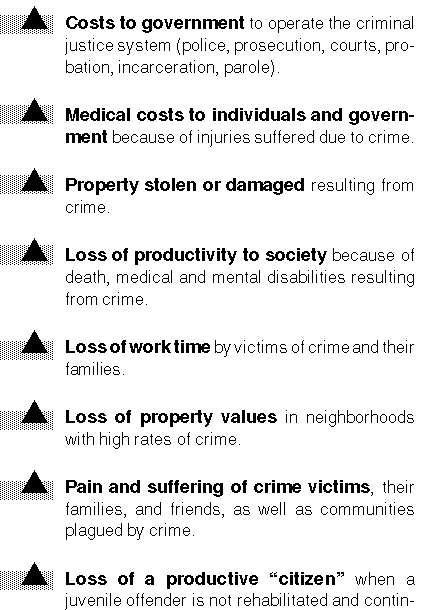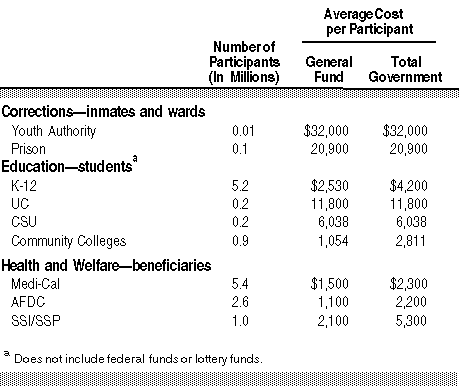May 1995
Please note:
See our January 2007
publication,
California’s Criminal Justice System: A Primer, which provides updated data
related to the juvenile justice system as well as answers to the following
questions: Who Are Juvenile Offenders? How Prevalent Is Juvenile Crime in
California? What Happens to Juvenile Offenders? It also discusses (a) reforming
the division of juvenile justice and (a) defining state and local
responsibilities for juvenile offenders.
Juvenile Crime--Outlook for California
Part VI
How Much Does Juvenile Crime Cost?
There is no simple answer to this difficult question. Although many studies over the years have tried to quantify the total direct and indirect costs of all crime (adult and juvenile) to government and society, the results have varied, but all conclude that nationwide costs are in the tens to hundreds of billions of dollars annually. Estimating the costs that are unique to juvenile crime is difficult, but the associated costs would probably be substantial.
Some costs of crime (such as the government's direct cost of fighting crime) can be readily estimated. For example, the most recent available data show that in 1992-93, California spent about $13.8 billion to fight crime, which included the costs for police, prosecution, courts, probation, and incarceration. How much of this cost is attributable to juvenile crime is harder to estimate. However, since a disproportionate share of crime is committed by juveniles, the cost for fighting juvenile crime is likely to be commensurately high.
Other costs cannot be easily measured. For example, many crimes go unreported or even undetected and thus their costs to society are not captured. Also, some costs are "transferred" by manufacturers and retailers to consumers in order to cover their costs for crime prevention activities or losses from crime.
What Is Considered a "Cost" of Crime?

- Costs to government to operate the criminal justice system (police, prosecution, courts, probation, incarceration, parole).
- Medical costs to individuals and government because of injuries suffered due to crime.
- Property stolen or damaged resulting from crime.
- Loss of productivity to society because of death, medical and mental disabilities resulting from crime.
- Loss of work time by victims of crime and their families.
- Loss of property values in neighborhoods with high rates of crime.
- Pain and suffering of crime victims, their families, and friends, as well as communities plagued by crime.
- Loss of a productive "citizen" when a juvenile offender is not rehabilitated and continues to commit crime.
State Incarceration of Juveniles Has the Highest Per Capita Cost
1994-95

- Youth Authority wards have the highest cost but are the least numerous. For example, it costs $32,000 to house a Youth Authority ward in 1994-95, but $4,200 to educate a student in K-12 school.
- The costs shown are averages. The range of individual costs is especially large in the Medi-Cal Program. Nursing home patients in the Medi-Cal Program, for example, cost about $25,000 annually to support.
What Are the Policy Implications?
The major policy implications of the data presented in this report are summarized briefly below.
Recognize the Divergence of Crime Data and Public Perceptions of Crime. Juvenile crime, as measured by arrest rates, peaked in the mid-1970s and declined through most of the 1980s, but has started to rise again. While juvenile arrest rates have been increasing recently, they still are below the levels of the 1970s. Juveniles commit a disproportionate number of crimes, in comparison to their proportion of the state's population, while adults are responsible for most crime. One of the state's most alarming criminal trends, though, has been the growth of juvenile arrests for violent crimes, particularly homicide. While these crimes make up a small portion of all crimes committed, they constitute a large part of the public's perception of crime. Both public perceptions and crime data should be taken into account by decisionmakers when shaping public policy affecting the state's juvenile justice system.
Recognize That the Juvenile Justice System Is Different From the Adult System. The underlying philosophy of the state's juvenile justice system is to treat and rehabilitate juveniles. In contrast, the adult system has as its primary goal the apprehension and punishment of adult offenders.
In some respects, the current juvenile justice system with its emphasis on rehabilitation reflects an earlier era when juveniles committed relatively minor nonviolent crimes. Today, however, the juvenile justice system is receiving increasing numbers of juveniles who have committed serious violent crimes, some having committed heinous offenses.
Policymakers could make scarce prevention, intervention, and rehabilitation resources go further by defining which offenders are most amenable to treatment. For example, currently a juvenile who commits a ruthless crime and is sentenced to 25 years to life is likely to receive the same array of services in the CYA as a youth who has committed a nonviolent offense. Such a violent offender would have access to both regular and special education, as well as specialized services, such as substance abuse programs. While we are not suggesting that these offenders receive no services, given limited resources, policymakers may want to limit the amount of services to these offenders so that they do not receive all of the services the Youth Authority has to offer. This may be especially appropriate in their early years of incarceration, when their return to the community is decades away. Instead, services could be targeted to meet more pressing needs.
Recognize the Importance of Demographics in Juvenile Crime. As we indicated, juveniles commit a disproportionate amount of crime. The decline in juvenile crime, as measured by arrest rates in the 1980s, was due, in part, to the decline in the number of juveniles. The juvenile population is again growing, especially those aged 11 to 17. We estimate that this segment of the population will increase over 29 percent through the year 2004, and that juvenile crime is likely to increase commensurately. For these reasons, it is important for policymakers to recognize that the changing demographics--particularly the increase in the number of juveniles--could result in a return to higher crime rates in the relatively near future.
Place a Priority on Prevention and Early Intervention. The vast majority of juvenile offenders commit just one or two offenses and never offend again. A small number of juveniles commit the majority of criminal offenses and these juveniles--chronic recidivists--often begin their careers at an early age (age 11). They also tend to exhibit at an early age a variety of risk factors, such as school behavior and performance problems, significant family problems, and substance abuse.
Given the high costs of crime to society and research that indicates that efforts to rehabilitate chronic recidivists have limited success, an important course of action is to intervene with offenders at an early age in order to prvent further criminal activity. Early intervention could include a "package" of integrated services--criminal justice, education, social services, substance abuse, and mental health resources.
Additionally, policymakers should consider cost-effective programs that reduce the risk factors of juveniles ever getting involved in criminal activities. For example, programs that keep juveniles from dropping out of school, reduce child abuse, teach parenting skills, preserve families, provide substance abuse treatment (for parents and juveniles), and provide alternatives to criminal "lifestyles" could help to reduce juvenile crime.
Target Violent Juvenile Crime. Juvenile arrest rates for violent crime have generally exceeded those for adults since 1980. Given this trend and the negative consequences of violence, crime reduction efforts should be targeted at reducing violent juvenile crime.
Certain types of activities tend to make juvenile crime more violent or magnify the effects of that violence. For example, gang activity is primarily a juvenile problem and leads to a disproportionate amount of violent crime. Gang activity can potentially be reduced if alternatives to gangs are available, either through the schools or the community, and law enforcement suppression efforts are increased.
In addition, juvenile violence could be reduced by limiting the number of firearms illegally possessed by juveniles. Recent research from experiments in Kansas City showed that the use of a limited number of law enforcement personnel whose sole responsibility was to seize illegal guns in gun "hot spots" increased gun seizures by 65 percent and reduced the incidence of violence by 49 percent. A comparison area of the city that did not have such targeted patrols, saw gun-related crime increase slightly during the same period. Part of the increase might have been due to gun-related crime being "displaced" from the targeted areas to other parts of the city.
Finally, research has shown that the use of alcohol is closely associated with violent behavior, especially for juveniles. There are already laws on the books that make it illegal for a person to sell alcohol to a juvenile and for a juvenile
to consume alcohol. Strong enforcement of liquor laws, along with prevention activities, could help prevent juvenile violence.
Recognize That the Greater Use of Incarceration May Have a Limited Effect on Juvenile Crime. There is no question that incarceration has an important role to play in the juvenile justice system. Juveniles who are chronic recidivists, violent, or have severe disorders (such as sex offenders) should be incarcerated. While incarcerated, these individuals will not be able to commit additional crimes. For juveniles, incarceration has the added benefit of providing a variety of services for those in need of them.
However, whether increased imprisonment of juveniles will significantly reduce overall crime is problematic. First, most juveniles are not incarcerated until they have a well-established pattern of criminal activity (Youth Authority wards have often been arrested eight or more times before being sent to the Youth Authority). Alternative punishments that are "swift and certain" after a first offense--such as, making graffiti vandals clean up graffiti--have been shown to be more effective at deterring juvenile crime than the possibility of detention after multiple offenses.
Secondly, because of the continuing growth in the juvenile population, there will always be "new" offenders to "replace" the juvenile offenders who have been incarcerated. With a projected juvenile population increase of almost 30 percent, it would be very expensive for state and local agencies to build a sufficient number of detention beds to incarcerate all juvenile offenders.
Recognize That Better Information Is Needed to Reduce Juvenile Crime. Better information is needed to understand the scope and causes of juvenile crime in California and to develop the most cost-effective methods to combt that crime. For example, policymakers would benefit from knowing the disposition of juvenile arrests.
Also, policymakers need better data on program "outcomes," in order to determine which programs work and which ones don t. For example, it would be helpful to know how many juveniles after being incarcerated in county ranches or camps do not commit a new offense, or how many Youth Authority parolees, who have earned their high school diploma, are successful in the community. This type of information would allow resources to be directed to those programs that best lead to the end of criminal behavior.
State policymakers also need better information on gangs and gang-related crime. Currently, crime statistics are not broken out by gang and nongang affiliation; such information would be valuable for committing resources to areas most needing gang suppression. Policymakers also need better information on juvenile gun possession and the use of alcohol. Such data could help reduce the incidence of juvenile crime.
This report was prepared by Clifton Curry under the supervision of Craig Cornett. For information about this report call Mr. Curry at (916) 445-4660. For additional copies contact the Legislative Analyst's Office, State of California, 925 L Street, Suite 1000, Sacramento, CA 95814, (916) 445-2375.
Return Juvenile Crime Table of Contents
Visit the 2007 Publication, California’s Criminal Justice
System: A Primer
Return to LAO Home Page